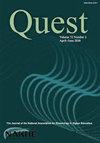体育课程干预:研究模式与干预效果综述
IF 1.7
3区 教育学
Q2 EDUCATION & EDUCATIONAL RESEARCH
引用次数: 2
摘要
摘要:本文献综述的目的是(a)描述现有体育课程干预研究的模式,以及(b)确定这些干预的有效性。我们遵循预先建立的文献回顾方案来搜索、识别、筛选和分析与体育课程干预相关的学术研究。审查的年份范围为1995年至2021年10月。这一过程产生了48篇符合纳入标准的文章,这些文章被合成以解决研究目的。我们计算了Cohen’s d来量化几种常用研究结果的干预效应大小,包括身体活动(PA)、身体组成、身体健康、运动技能能力、知识和认知、幸福感和社会能力。该综述显示,与前十年(n = 12)相比,2009年至2021年(n = 36)对体育课程干预的研究呈增加趋势。大多数体育干预涉及对照组(n = 41);在北美(n = 23)和欧洲(n = 15)进行;大多数发表在健康(n = 19)和运动机能学期刊(n = 18)。干预对所有结局的综合影响均为小到中等(d = 0.24)。个别结果变量的效应量分别报告。研究结果对未来体育课程干预的设计、实施和评价具有指导意义。本文章由计算机程序翻译,如有差异,请以英文原文为准。
Physical Education Curriculum Interventions: A Review of Research Patterns and Intervention Efficacy
ABSTRACT The purposes of this literature review were (a) to describe the patterns of the existing research on physical education (PE) curriculum interventions, and (b) to determine the efficacy of these interventions. We followed a pre-established literature review protocol to search, identify, screen, and analyze the scholarship related to PE curriculum interventions. The year range of the review was between 1995 and October, 2021. This process yielded 48 articles that met the inclusion criteria, which were synthesized to address the research purposes. We calculated Cohen’s d to quantify the intervention effect sizes on several commonly studied outcomes including physical activity (PA), body composition, physical fitness, motor skill competence, knowledge and cognition, and well-being and social competence. The review revealed an increasing trend for research on PE curriculum interventions between 2009 and 2021 (n = 36) compared to the decade before (n = 12). A majority of these PE interventions involved a control group (n = 41); were conducted in North America (n = 23) and Europe (n = 15); and most were published in health (n = 19) and kinesiology journals (n = 18). The intervention effects on all outcomes combined were small to medium (d = 0.24). Effect sizes for the individual outcome variables of interest were reported separately. The findings with regard to the patterns and intervention efficacy may be useful to guide the design, execution, and evaluation of future PE curriculum interventions.
求助全文
通过发布文献求助,成功后即可免费获取论文全文。
去求助
来源期刊

Quest
社会科学-运动科学
CiteScore
4.50
自引率
14.30%
发文量
16
期刊介绍:
Quest is the official journal of the National Association for Kinesiology in Higher Education (NAKHE). It is the leading journal for interdisciplinary scholarship for professionals in kinesiology in higher education. Quest provides a public forum for scholarship, creative thought, and research relevant to a broad range of interests held by faculty and leaders in higher education today.
Quest publishes: 1) manuscripts that address issues and concerns relevant and meaningful to the field of kinesiology; 2) original research reports that address empirical questions that are contextualized within higher education and hold significance to a broad range of faculty and administrators in kinesiology; and 3) reviews of literature and/or research of interest to one or more sub-disciplines in kinesiology. Quest does not publish papers focused on sport (e.g., amateur, collegiate, professional) that are contextualized outside of kinesiology in higher education.
 求助内容:
求助内容: 应助结果提醒方式:
应助结果提醒方式:


